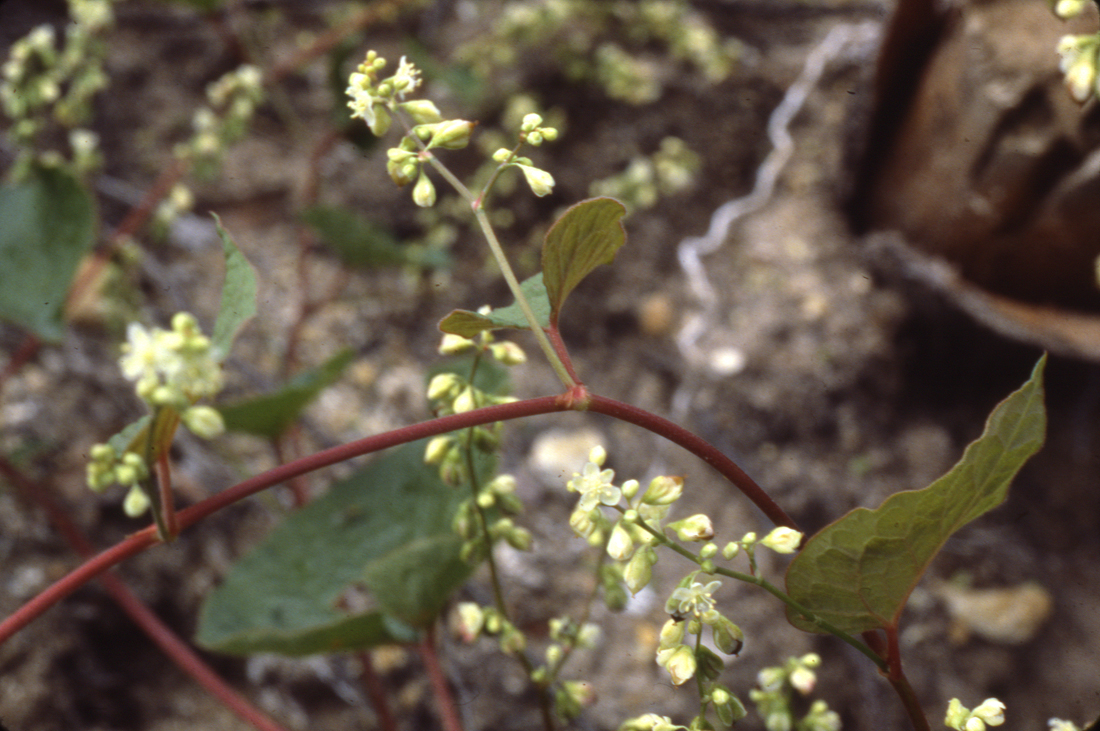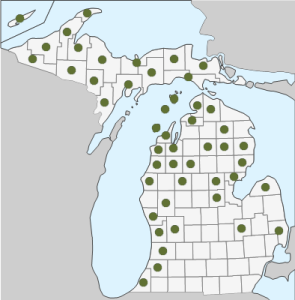 Download PDF
Download PDF
Name: Fallopia cilinodis (Michx.) Holub
Family: Polygonaceae, the Buckwheat Family
Common Names: Fringed black bindweed (1), fringed bindweed (2), blackfringe knotweed (12)
Etymology: Fallopia was named for Gabriello Fallopio, a 16th century professor of botany and anatomy (7). Cilinode comes from the Latin cilium and nodus, meaning “hair” and “node” respectively, referring to the fringe of hairs at each vegetative node (8).
Botanical synonyms (1):
Bilderdykia cilinodis (Michx.) Greene
Bilderdykia cilinodis var. laevigata (Fern.) C.F. Reed
Polygonum cilinode Michx
Polygonum cilinode var. laevigatum Fern. Reynoutria cilinodis (Michx.) Shinners
Tiniaria cilinodis (Michx.) Small
Quick Notable Features:
¬ stiff bristles fringing a reflexed ocrea (sheath at base of petiole)
¬ panicles of inconspicuous greenish white flowers
¬ leaves with wavy margins, pilose below, often with veins standing out with reddish color
Plant Height: Stems grow to a length of 0.3-5m (2,17).
Subspecies/varieties recognized: Fallopia cilinodis var. laevigatum Fern. (1,5). See “Interesting Factoid” below.
Most Likely Confused with: Dioscorea villosa, species of Convolvulus, Calystegia, and Ipomoea (Convolvulaceae), other Fallopia spp. in our area (F. convolvulus, F. scandens), and Smilax spp.
Habitat Preference: Dry woods, thickets, rocky slopes, and forest edges (2,5,13). Voss (6) notes that it is “characteristic of recently disturbed areas.”
Geographic Distribution in Michigan: Found in every county in the Upper Peninsula and about a third of the counties in the Lower Peninsula, mostly along the Great Lakes (6).
Known Elevational Distribution: Has been observed at elevations up to 720m in New York (11). Flora of North America (13) says it grows up to 900m.
Complete Geographic Distribution: Native to the United States, F. cilinodis is found from Georgia, Tennessee, and North Carolina north to Maine and west to Minnesota. In Canada, it is found from Quebec west to Saskatchewan (10).
Vegetative Plant Description: A perennial twining or scrambling herb. The stems of F. cilinodis are glabrous or pubescent with oblique ocrea reflexed and bristly, 3-4mm tall. With prolonged exposure to sunlight, the stems become red, and if there is no available support, the stems can be stout and erect. The deciduous, alternate leaves are simple, ovate or triangular with cordate bases, pilose below, borne on slender petioles, 5-12cm long and 2.5-10cm wide. Leaf margins are entire and wavy (2,3,5,13).
Climbing Mechanism: F. cilinodis is a stem twiner (5). It climbs sinistrally, or from right to left, an orientation that is relatively rare among stem climbers (personal observation, Robyn J. Burnham).
Flower Description: The ocreate panicles of F. cilinodis are borne on peduncles 4-10cm long, and can be terminal or axillary. The greenish white, sometimes pinkish, flowers are 4-7 per fascicle, 1.5-2mm long, with 3 + 2 elliptic tepals. Each flower has 6-8 glabrous or pubescent stamens, a triangular superior ovary, and three short divergent styles with capitate stigmas. After maturity, the three outer tepals expand to 4-5mm and become papery (2,5,13,17).
Flowering Time: June through September (2,3,4).
Pollinator: None found in the literature.
Fruit Type and Description: A very glossy black achene, 3-4 x 1.8-2.4mm. The three outer tepals persist after maturity, barely covering the achene. The tepals are occasionally winged and barely keeled (2,3,13).
Seed Description: None found in the literature, probably because the achene does not open.
Dispersal Syndrome: The papery calyx may aid in wind dispersal.
Distinguished by: Fallopia cilinodis can be distinguished from Dioscorea villosa by its veins: D. villosa has arcuate-parallel venation, with 7-11 veins converging at the leaf apex. Furthermore, the leaf nodes of D. villosa lack an ocrea, and its fruit is a large, three-winged capsule (2,3,4,5).
Generally, species of Convolvulaceae have latex in their stems and/or leaves, and F. cilinodis does not. Convolvulaceae fruits tend to be capsules, instead of achenes, and the stems lack an ocrea (2,3,4,5).
Smilax species climb with tendrils borne on the petioles, and have no ocrea at their leaf nodes. Additionally, Smilax species typically have arcuate, rather than reticulate, venation (2,3,4,5).
F. cilinodis is differentiated from other Fallopia species primarily through its open panicles and stiff hairs at the base of the ocrea; other climbing Fallopia have glabrous ocrea (12).
Other members of the family in Michigan: Fagopyrum (2), Fallopia (4), Polygonella (1), Polygonum (24), Rheum (1), Rumex (14) [10]
Ethnobotanical Uses: None found in the literature.
Phylogenetic Information: A study by Kim et al. (9) on flavonoid compounds in F. scandens, F. cilinodis, F. convolvulus, F. dentatoalata, and F. dumetorum found them to be closely related, but distinct species. Fallopia has been assigned to the Polygonoideae subfamily of the Polygonaceae, which is a member of the Caryophyllales, a member of the core eudicots within the angiosperms (15,16).
 Interesting Quotation or Other Interesting Factoid not inserted above: M.L. Fernald (14) described a localized, isolated population of F. cilinodis at Spruce Knob, West Virginia having sparsely pubescent to glabrous stems and leaves with a stouter calyx and plumper seeds. He compared the Spruce Knob specimens to 86 herbarium sheets of F. cilinodis collected from further north and decided, based on phenetic characters, that it was not unique enough to define as a new species. He named it F. cilinodis var. laevigatum, after the Latin laevigatus, meaning “smooth” (8). It is not known whether the population at Spruce Knob still exists.
Interesting Quotation or Other Interesting Factoid not inserted above: M.L. Fernald (14) described a localized, isolated population of F. cilinodis at Spruce Knob, West Virginia having sparsely pubescent to glabrous stems and leaves with a stouter calyx and plumper seeds. He compared the Spruce Knob specimens to 86 herbarium sheets of F. cilinodis collected from further north and decided, based on phenetic characters, that it was not unique enough to define as a new species. He named it F. cilinodis var. laevigatum, after the Latin laevigatus, meaning “smooth” (8). It is not known whether the population at Spruce Knob still exists.
Literature and websites used:
- ITIS: Integrated Taxonomic Information System. http://www.itis.gov/index.html Retrieved February 6, 2009 from the Integrated Taxonomic Information System on-line database.
- Gleason, H.A. and A. Cronquist. 1991. Manual of Vascular Plants of the Northeastern United States and Adjacent Canada. Bronx, New York, USA: New York Botanical Garden Press.
- Gleason, H.A. 1963. The New Britton and Brown Illustrated Flora of the Northeastern United States and Adjacent Canada. New York, New York, USA: Hafner Publishing Co., Inc.
- Radford, A.E., H.E. Ahles, and C.R. Bell. 1968. Manual of the Vascular Flora of the Carolinas. Chapel Hill, North Carolina, USA: The University of North Carolina Press.
- Fernald, M. L. 1950. Gray’s Manual of Botany, 8th ed. New York, USA: American Book Company.
- Voss, E. G. 1985. Michigan Flora Part II: Dicots. Ann Arbor, Michigan, USA: Cranbrook Institute of Science.
- Eycleshymer, A.C. 1917. Anatomical Names. New York City, New York, USA: William Wood & Co.
- Brown, R. W. 1956. Composition of Scientific Words. Washington, D.C., USA: Smithsonian Institution Press.
- Kim, M.H., J.H. Park, and C.W. Park. 2000. Flavonoid chemistry of Fallopia section Fallopia (Polygonaceae). Biochemical Systematics and Ecology 28(5): 433-441.
- USDA, NRCS. 2008. The PLANTS Database, Version 3.1, National Plant Data Center, Baton Rouge, LA 70874-4490 USA. http://plants.usda.gov/ (February 28, 2009).
- Peck, C.H. 1899. Plants of North Elba, Essex Count, N.Y. Albany, New York, USA: University of the State of New York Press.
- Hobbs, C.H. 1992. Occurrence and distribution of Polygonum species in Ohio. Ohio Journal of Science 92 (4): 88-97.
- Freeman, C.C. and H.R. Hinds. Fallopia. Flora of North America. http://www.efloras.org/florataxon.aspx?flora_id=1&taxon_id=250060602
- Fernald, M.L. 1914. The West Virginia variety of Polygonum cilinode. Rhodora 16: 165-166.
- ANGIOSPERM PHYLOGENY GROUP 2003. An update of the Angiosperm Phylogeny Group classification for the orders and families of flowering plants: APG II. Botanical Journal of the Linnean Society 141(4): 399-436.
- Zomlefer, W.B. 1994. Guide to Flowering Plant Families. Chapel Hill, North Carolina, USA: The University of North Carolina.
- Britton, N.L. & H.A. Brown 1970. An Illustrated Flora of the Northern United States and Canada: Volume I. New York, NY: Dover Publications, Inc.
Image Credits (all used with permission):
1. Image of flowers, stems, and leaves courtesy Dr. Edward G. Voss, University of Michigan.
2.Close up image of flowers © by Jeffrey S. Pippen, http://www.jeffpippen.com
3.Image of leaf © Louis-M Landry/CalPhotos.
3. Image of ocreac Louis-M Landry/CalPhotos.
4. Species distribution map, derived from the Michigan Flora Online.
Primary Author: Becca Sonday with additions from John Bradtke, Robyn J. Burnham, and Cristine V. Santanna.
© Robyn J. Burnham
For additional information on Michigan Plant Diversity web pages please contact Robyn J. Burnham via email: rburnham“at”umich.edu